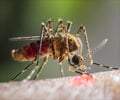Even as health officials warn against a West Nile epidemic in the United States this summer, scientists have pinpointed what makes the disease -- unknown in North America a decade ago -- so deadly, according to a study released Sunday.
The US researchers identified a single genetic mutation that causes the virus to become far more virulent, leading to increased mortality in wild birds and, almost certainly, in humans.In an experiment, American crows, especially susceptible to the disease, died at a much higher rate -- 94 rather than 31 percent -- when exposed to the more lethal strain.
Most cases in humans are benign, with only minor symptoms. But extreme cases can result in tremors, fever, coma, and a lethal swelling of the brain tissue known as encephalitis.
West Nile virus is carried by birds and spreads to human by mosquitos.
The study, published in the British journal Nature, also showed that the same mutation was "positively selected," meaning that it "gives the virus a fitness advantage and enhances its ability to replicate," lead author Aaron Brault, from the University of California at Davis, told AFP.
This makes it easier for the disease to adapt rapidly to changing environments, with unpredictable consequences for human health, he said.
Advertisement
In its ability to spread quickly, "it is about as successful a virus as we have seen," he added.
Advertisement
While only a dozen deaths have been reported so far this year, there has been a fourfold increase in the number of cases reported in the United States compared to the same time in 2006, according the US government Centers for Disease Control. That has prompted warnings of a possible epidemic.
On Friday, Governor Arnold Schwarzenegger of California released nearly 900,000 dollars (650,000 million euros) to combat its spread.
The genetic mutation that researchers were able to replicate in the laboratory involved the introduction of a specific amino acid -- known as T249P -- into the gene encoding an enzyme called a helicase.
The study found the same mutation had occured in samples from recent outbreaks of the disease in Europe and Israel that also led to human fatalities.
Isolating the lethal mutation "opens the door to developing anti-viral therapies," noted Brault, though it was too soon to say when.
West Nile virus was first isolated in Uganda in the 1930s, and has since been reported in birds and horses in much of Africa, Europe, the Middle East along with west and central Asia.
In the 1990s, outbreaks of encephalitis in humans caused by the virus also occurred in Algeria, Romania, the Czech Republic, Congo, Russia, and Israel.
Since first appearing in North America in 1999, there have been more than 24,000 human cases in the United States, with some 1,000 fatalities.
Some scientists have suggested the spread of the tropical West Nile virus to colder climes is a warning sign about the possibly devastating health consequences of global warming, which may be facilitating the spread of tropical, insect-born diseases into more temperate zones.
Source-AFP
LIN/J






